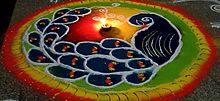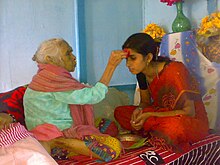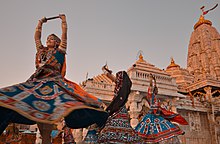Shyama Prasad Mukherjee (6 July 1901 – 23 June 1953) was an Indian politician, barrister and academician, who served as
Minister for Industry and Supply in Prime Minister
Jawaharlal Nehru's cabinet. After falling out with Nehru, Mukherjee quit the
Indian National Congress and founded the right wing nationalist
Bharatiya Jana Sangh (which would later evolve into
BJP) in 1951.
He was also the President of
Akhil Bharatiya Hindu Mahasabha from 1943 to 1946. Mukherjee was strongly opposed to
Article 370 seeing as a threat to unity of the country and fought against it inside and outside of the parliament with one of the goals of Bharatiya Jana Sangh being abrogation of the article. He died in 1953 under mysterious circumstances.
Early life and academic career
Shyama Prasad Mukherjee was born in a
Bengali Kulin Brahmin family on 6 July 1901 in Calcutta (
Kolkata). His father was Sir
Ashutosh Mukherjee, a judge of the
High Court of Calcutta, Bengal, who was also
Vice-Chancellor of the
University of Calcutta.His mother was Lady Jogamaya Devi Mukherjee.
He enrolled as an advocate in
Calcutta High Court in 1924, the same year in which his father had died. Subsequently, he left for England in 1926 to study at
Lincoln's Inn and was
called to the
English Bar in the same year. At the age of 33, he became the youngest Vice-Chancellor of the University of Calcutta in 1934, and held the office till 1938. It was during his term as Vice-Chancellor of the Calcutta University that
Rabindranath Tagore delivered the University Convocation Address in Bengali for the first time in history and the Indian vernacular was introduced as a subject for the highest examination in the university.
Political career before independence
Shyama Prasad Mukherjee started his political career in 1929, when he entered the Bengal Legislative Council as an
Indian National Congress (INC) candidate representing Calcutta University.
[ However, he resigned the next year when the INC decided to boycott the legislature. Subsequently, he contested the election as an independent candidate and was elected in the same year. In
1937, he was elected as an independent candidate in the elections which brought the
Krishak Praja Party-
All India Muslim League coalition to power. He served as the Finance Minister of Bengal Province in 1941–42 under
A.K. Fazlul Haq's Progressive Coalition government which was formed on 12 December 1941 after the resignations of Muslim League ministers of the government. During his tenure, his statements against the government were censored and his movements were restricted. He was also prevented from visiting the
Midnapore district in 1942 when severe floods caused a heavy loss of life and property. He resigned on 20 November 1942 accusing the British government of trying to hold on to India under any cost and critisiced its repressive policies against the
Quit India Movement. After resigning, he mobilised support and organised relief with the help of
Mahabodhi Society,
Ramakrishna Mission and Marwari Relief Society. In
1946, he was again elected as an independent candidate from the Calcutta University. He was elected as a member of the
Constituent Assembly of India in the same year...
Leader of the Hindu Mahasabha
Mukherjee joined the
Hindu Mahasabha in Bengal in 1939 and became its
acting president in the same year.He was appointed as the
working president of the organisation in 1940. On 11 February 1941, Mukherjee told a Hindu rally that if Muslims wanted to live in Pakistan they should "pack their bag and baggage and leave India ... (to) wherever they like". He was elected as the President of Akhil Bharatiya Hindu Mahasabha in 1943.He remained in this position till 1946, with Laxman Bhopatkar becoming the new President in the same year.
Mukherjee demanded the partition of Bengal in 1946 to prevent the inclusion of its Hindu-majority areas in a Muslim-dominated
East Pakistan A meeting held by the Mahasabha on 15 April 1947 in
Tarakeswar authorised him to take steps for ensuring partition of Bengal. On 2 May 1947, he wrote a letter to
Lord Mountbatten telling him that Bengal must be partitioned even if India wasn't partitioned. He also opposed a failed bid for a
united but independent Bengal made in 1947 by
Sarat Bose, the brother of
Subhas Chandra Bose, and
Huseyn Shaheed Suhrawardy, a
Bengali Muslim politician.
His views were strongly affected by the
Noakhali genocide in
East Bengal, where mobs belonging to the Muslim League massacred Hindus in large numbers.
Opposition to Quit India Movement
Following the Hindu Mahasabha's official decision to boycott the
Quit India movement and the
Rashtriya Swayamsevak Sangh's decision of non-participation in the movement, Mukherjee wrote a letter to the British Government as to how they should respond to "Quit India" movement. In this letter, dated July 26, 1942 he wrote:
"Let me now refer to the situation that may be created in the
province as a result of any widespread movement launched by the
Congress. Anybody, who during the war, plans to stir up mass feeling,
resulting internal disturbances or insecurity, must be resisted by any
Government that may function for the time being"
Mukherjee in this letter reiterated that the Fazlul Haq-led Bengal Government, along with its alliance partner Hindu Mahasabha would make every possible effort to defeat the
Quit India Movement in the province of Bengal and made a concrete proposal in regard to this:
"The question is how to combat this movement (Quit India) in Bengal?
The administration of the province should be carried on in such a manner
that in spite of the best efforts of the Congress, this movement will
fail to take root in the province. It should be possible for us,
especially responsible Ministers, to be able to tell the public that the
freedom for which the Congress has started the movement, already
belongs to the representatives of the people. In some spheres it might
be limited during the emergency. Indians have to trust the British, not
for the sake for Britain, not for any advantage that the British might
gain, but for the maintenance of the defense and freedom of the province
itself. You, as Governor, will function as the constitutional head of
the province and will be guided entirely on the advice of your Minister.
Even the Indian historian
R.C. Majumdar noted this fact and states:
"Shyam Prasad ended the letter with a discussion of the mass movement
organised by the Congress. He expressed the apprehension that the
movement would create internal disorder and will endanger internal
security during the war by exciting popular feeling and he opined that
any government in power has to suppress it, but that according to him
could not be done only by persecution ... In that letter he mentioned
item-wise the steps to be taken for dealing with the situation ..."
During his resignation however, he did characterise the policies of the British government towards the movement as "repressive".
Prime Minister
Jawaharlal Nehru inducted Mukherjee into the Interim Central Government as a
Minister for Industry and Supply on 15 August 1947. Mukherjee began to have differences with Mahasabha after the
assassination of Mahatma Gandhi, in which the organisation was blamed by
Sardar Patel for creation of an atmosphere in the country that led to Gandhi's killing. Mukherjee suggested the organisation to suspend its political activities and left the organisation in December 1948 shortly after it did so. One of his reasons for leaving was also the rejection of his proposal to allow non-Hindus to become members.
[27][47][48]
Mukherjee resigned along with
K.C. Neogy from the Cabinet on 8 April 1950 over a disagreement about the
1950 Delhi Pact with Pakistani Prime Minister
Liaquat Ali Khan. Mukherjee was firmly against their joint pact to establish minority commissions and guarantee minority rights in both countries as he thought it left Hindus in East Bengal to the mercy of Pakistan. While addressing a rally in Calcutta on 21 May, he stated that an exchange of population and property at governmental level on regional basis between East Bengal and
Indian states of
Tripura,
Assam,
West Bengal and
Bihar was the only option in the current situation.
[47][49][50]
After consultation with
M. S. Golwalkar of the
Rashtriya Swayamsevak Sangh (RSS), Mukherjee founded the Bharatiya Jana Sangh on 21 October 1951 in Delhi and he became its first President. In the 1952 elections, the
Bharatiya Jana Sangh (BJS) won 3 seats in the
Parliament of India including Mukherjee's own seat. He had formed the National Democratic Party within the Parliament which consisted of 32
members of the Lok Sabha and 10
members of the
Rajya Sabha which, however, was not recognised by the speaker as an opposition party. The BJS was created with the objective of
nation-building and "nationalising" all non-Hindus by "inculcating
Bharatiya Culture" in them. The party was ideologically close to the RSS and widely considered the proponent of
Hindu Nationalis.
Opinion on special status of Jammu and Kashmir
Mukherjee was strongly opposed to
Article 370 seeing as a threat to unity of the country and fought against it inside and outside of the parliament with one of the goals of Bharatiya Jana Sangh being abrogation of the article. He termed the arrangements under the article as
Balkanization of India and three-nation theory of
Sheikh Abdullah. The state was granted its own flag along with Prime Minister whose permission was required for anyone to enter the state. In opposition to this, Mukherjee once said
"Ek desh mein do Vidhan, do Pradhan aur Do Nishan nahi chalenge" (A single country can't have two
constitutions, two
prime ministers, and two
national emblems).
] Bharatiya Jana Sangh along with Hindu Mahasabha and
Jammu Praja Parishad launched a massive Satyagraha to get the provisions removed.
Mukherjee went to visit Kashmir in 1953 illegally, and observed a hunger strike to protest the law that prohibited Indian citizens from settling within the state and mandating that they carry ID cards. Mukherjee wanted to go to Jammu and Kashmir but, because of the prevailing permit system, he was not given permission. He was arrested on 11 May at
Lakhanpur while crossing the border into Kashmir illegally. Although the ID card rule was revoked owing to his efforts, he died as a détenu on 23 June 1953 under mysterious circumstances
.
SOME POISIONOUS INJECRTION WAS GIVEN TO HIM ON THE INSTRUCTIONS BY SHEKH ABDULLAH THAN PM OF KASHMIR BY DR.ALI JAN OF KASHMIR ADVISED BY JAWAHAR LAL NEHRU .
However, before his death, he had agreed to a formulation of autonomy for Jammu and Kashmir with further autonomy for each region of Jammu, Kashmir and Ladakh. In a letter on 17 February 1953 to Nehru in which he suggested:
[60] "(1) Both parties reiterate that the unity of the State will be maintained and that the principle of autonomy will apply to the province of Jammu and also to Ladakh and Kashmir Valley. Implementation of Delhi agreement—which granted special status to the State—will be made at the next session of Jammu and Kashmir Constituent Assembly."
According to
Balraj Madhok, who later on became the President of the Jana Sangh, the party withdrew its commitment to the State autonomy and regional autonomy under the directive from the RSS headquarters in
Nagpur
Death
Mukherjee was arrested on entering Kashmir on 11 May 1953.
[71] He along with two of his arrested companions was earlier taken to Central Jail of
Srinagar. Later they were transferred to a
cottage outside the city. His condition started deteriorating and he started feeling pain in the back and high temperature on the night between 19 and 20 June. He was diagnosed with dry
pleurisy from which he had also suffered in 1937 and 1944. The doctor Ali Mohammad prescribed him a
streptomycin injection and powders, however he informed that his family physician had told him that streptomycin did not suit his system. The doctor however told him that new information about the drug had come to light and assured him that he would be fine. On 22 June, he felt pain in the heart region, started prespiring and started feeling like he was fainting. He was later shifted to a hospital and provisionally diagnosed with a
heart attack. He died a day later under mysterious circumstances. The state government declared that he had died on 23 June at 3:40 a.m. due to a heart attack.
His death in custody raised wide suspicion across the country and demands for an independent enquiry were raised, including earnest requests from his mother, Jogamaya Devi, to Jawaharlal Nehru. Nehru declared that he had inquired from a number of persons who were privy to the facts and, according to him, there was no mystery behind Mukherjee's death. Jogamaya Devi did not accept Nehru's reply and requested the setting up of an impartial enquiry. Nehru, however, ignored the letter and no enquiry commission was set up. Mukherjee's death therefore remains a matter of some controversy.
Only one nurse, Rajdulari Tiku was present by his side in the hospital. According to her, when Mukherjee started crying in agony for a doctor, she fetched Dr. Jagannath Zutshi. The doctor found him in a grave condition and called Dr. Ali. Mukherjee's condition kept deteriorating and he died at 2:25 a.m.
S.C. Das claims that Mukherjee was murdered alleging that the nurse told Mukherjee's daughter Sabita that Zutshi gave his father a poisonous powder after which he started screaming and died.
Atal Bihari Vajpayee claimed in 2004 that the arrest of Mukherjee in Jammu and Kashmir was a "Nehru conspiracy
On 22 April 2010, the
Municipal Corporation of Delhi's (MCD) newly constructed Rs. 650-crore building (the tallest building in Delhi) was named the Doctor Syama Prasad Mukherjee Civic Centre. The Civic Centre was inaugurated by
Home Minister P. Chidambaram. The building, which is estimated to cater to 20,000 visitors per day, will also house different wings and offices of the MCD The MCD also built the Syama Prasad Swimming Pool Complex which hosted aquatic events during the
2010 Commonwealth Games held at New Delhi.
On 27 August 1998, the
Ahmedabad Municipal Corporation named a bridge after Mukherjee.
Delhi has a major road named after Mukherjee called Shyama Prasad Mukherjee Marg.
[86] Kolkata too has a major road called Shyama Prasad Mukherjee Road.
In 2001, the main research funding institute of the Government of India,
CSIR, instituted a new fellowship named after him. On 15 January 2012, a flyover at
Mathikere in
Bangalore City Limits was inaugurated and named the Dr Syamaprasad Mukherjee Flyover. The
International Institute of Information Technology, Naya Raipur is named after him.
In 2014, a
multipurpose indoor stadium built on the
Goa University campus in
Goa was named after Mukherjee. In 2015, the Government of India launched Shyama Prasad Mukherjee Rurban Mission to drive economic, social and infrastructure development in rural areas and create 300
rurban areas to stem increasing migration to urban areas. This scheme was operationalized in February 2016
.
The government of India approved the Shyama Prasad Mukherji Rurban Mission (SPMRM) with an outlay of Rs. 5142.08 crores on 16 September 2015. The Mission was launched by the Prime Minister on 21 February 2016 at Kurubhata, Murmunda Rurban Cluster, Rajnandgaon, Chhattisgarh.
SORCES : WIKIPEDIA AND OTHER BOOKS
POSTED BY : VIPUL KOUL
EDITED BY :ASHOK KOUL























